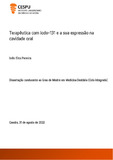Terapêutica com iodo-131 e a sua expressão na cavidade oral
Abstract
Introdução: Ao longo dos últimos anos, o número de casos de cancro tem vindo a aumentar, incluindo o cancro da tiroide. Portanto, existe um maior número de terapêuticas com I-131 a serem realizadas. Sabendo que o I-131 não é apenas captado pela tiroide e tendo em conta que o mesmo apresenta uma semivida biológica relativamente longa, é de extrema importância a compreensão dos efeitos que este pode provocar na cavidade oral.
Objetivos: Analisar e identificar os efeitos da terapêutica da tiroide com I-131 na cavidade oral, avaliando a necessidade de acompanhamento médico-dentário e eventuais cuidados a ter.
Material e Métodos: Foi realizada uma pesquisa na base de dados PubMed em fevereiro de 2022, por um período de 10 anos.
Resultados: A pesquisa inicial resultou na identificação de 82 artigos. 50 foram eliminados pela leitura do título e resumo, por não obedecerem aos critérios de elegibilidade. Apenas 32 artigos foram designados para a segunda fase de seleção, através da avaliação do texto completo. Após a leitura na íntegra foram selecionados 21 artigos.
Conclusão: De acordo com os resultados, algumas das reações adversas causadas pelo tratamento com I-131 são xerostomia/hipossalivação e sialoadenite. A cintilografia e a TC com/sem contraste, demonstraram ser técnicas eficazes no diagnóstico de disfunção das glândulas salivares. Tendo em consideração que nem todas as reações adversas se verificam no imediato da terapêutica, no futuro, será necessário a realização de mais estudos a longo prazo que contemplem uma monitorização da cavidade oral. Introduction: Over the last few years, the number of cancer cases has increased, including thyroid cancer. Therefore, there is a greater number of therapies with I-131 to be performed. Knowing that I-131 is not only taken up by the thyroid and taking into account that it has a relatively long biological half-life, it is extremely important to understand the effects it can cause in the oral cavity.
Objectives: To analyze and identify the effects of thyroid therapy with I-131 in the oral cavity, evaluating the need for medical and dental follow-up and possible care to be taken.
Material and Methods: The search was carried out in the PubMed database in February 2022, for a period of 10 years.
Results: The initial search resulted in the identification of 82 articles. 50 were eliminated by reading the title and abstract, as they did not meet the eligibility criteria. Only 32 articles were designated for the second phase of selection, through full text evaluation. After reading in full, 21 articles were selected.
Conclusion: According to the results, some of the adverse reactions caused by the treatment with I-131 are xerostomia/hyposalivation and sialoadenitis. Scintigraphy and CT with/without contrast have been shown to be effective techniques in the diagnosis of salivary gland dysfunction. Considering that, not all adverse reactions occur immediately after therapy. In the future, further long-term studies will need to be carried out that include monitoring of the oral cavity.

